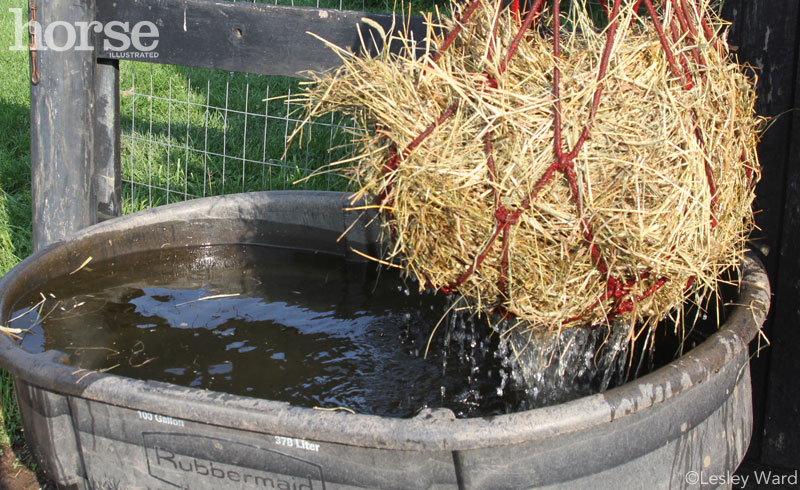
Most horse people have heard of the practice of soaking hay before feeding it. Hay has long been soaked in water as a way to get rid of dust. Horses with recurrent airway obstruction, allergies or other respiratory conditions shouldn’t eat dusty hay, and leaving hay soaking for a while before feeding it ensured less dust.
“Soaking removes sugars and fructans, known as water soluble carbohydrates, as well as some starch,” says Juliet M. Getty, PhD, of Getty Equine Nutrition in Waverly, Ohio, author of Feed Your Horse Like a Horse. “The warmer the water temperature and the longer you soak it, the more you remove.”
According to Getty, researchers at the University of Minnesota have confirmed that starch levels decline significantly when hay is soaked in warm water for 30 minutes or cold water for 60 minutes.
Why remove the sugar and starch? Because too much of these elements can cause problems for horses that are easy keepers, or insulin resistant (IR). Easy keepers put on weight faster when eating non-soaked hay and are susceptible to laminitis, and insulin resistant horses are also at risk of founder if their diet contains too much sugar and starch.
While soaking your horse’s hay is a good way to cut down on sugar and starch, there is a downside. Soaking leaches the minerals from the hay, and leaves your horse with less digestible fiber. If hay is soaked for more than two hours, bacteria can begin to grow. The way to solve these problems is to give your horse a mineral supplement and don’t allow the hay to soak longer than 60 minutes.
An alternative to soaking is steaming. Steaming reduces the amount of sugar and starch in the hay, but doesn’t leech as many minerals. The high temperature involved in steaming also kills dust mites, as well as various types of bacteria and fungal spores.
Steaming is easier too. Unlike with soaking, hay that has been steamed is not dripping with water, making it easier to handle. The steaming process is less work intensive than soaking, and you can steam hay well in advance of feeding it.
The downside to steaming is the cost of the steamer. Commercially made steamers run anywhere from $850 to $2500, depending on the size. Some horse owners opt to make their own steamers, but this requires some engineering skills.
Overall, if you have a horse that tends to gain weight or has been diagnosed with IR or another metabolic disease like Cushings, soaking—or steaming—may be a good option to keep your horse as healthy as possible.
Audrey Pavia is a freelance writer and the author of Horses for Dummies. She lives with two Spanish Mustangs, Milagro and Rio.






Good information and even learned a few new things.